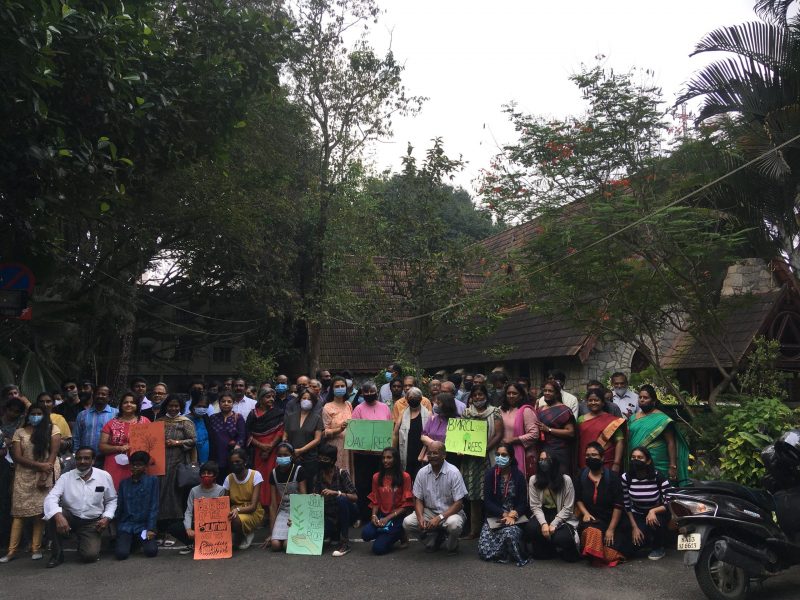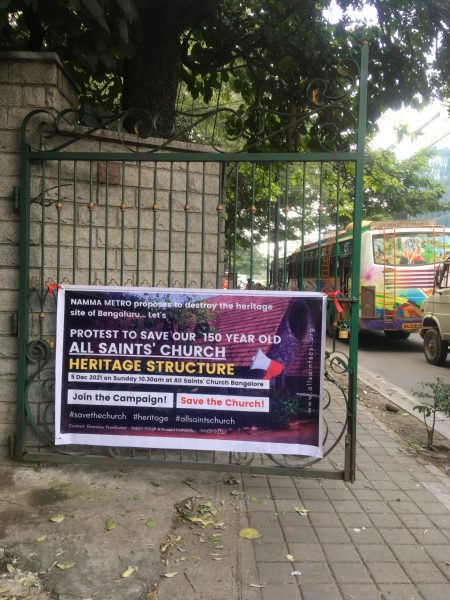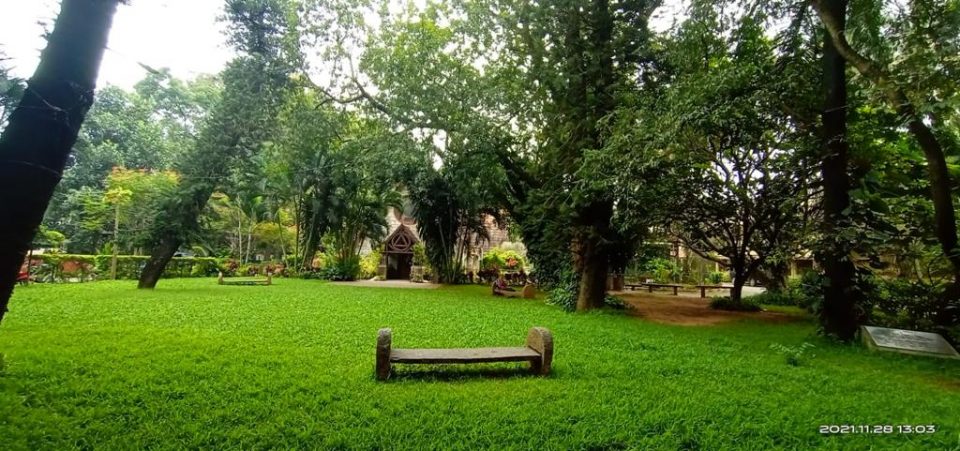
At green crossroads, Bengaluru Metro finds an old church’s tree lovers
In November, government authorities issued a preliminary notification to acquire a portion of land, cutting through the church grove, rattling the congregation, which responded with protest meetings.

It’s Christmas season and parishioners of the 152-year-old All Saints Church in downtown Bangalore gathered this Sunday for a day of carol singing and activity — the setting was the verdant driveway to their church just outside, which is one of Bangalore’s busiest thoroughfares.
Only, this was no festive occasion but a protest demonstration, a last-ditch effort by the church members to enlist support to save their grove of trees from being taken over for metro-rail work. Beneath the church, tunnelling for an underground line of the metro rail is proceeding, and the portion that the grove stands on has been earmarked for excavation, in order to construct an underground station. Heritage conservationists and tree-lovers have joined the protest that has been going on for three years now – indeed, much has happened in all this time, even a mediation with the Bangalore Metro Rail Corporation Ltd (BMRCL). But a mutually agreeable resolution has been elusive so far.
This underground metro-line running north-south will criss-cross the heart of the city and, hence, is crucial to decongesting Bangalore. Like most metro reaches in the city, this line too has run into long delays and BMRCL is now eyeing a 2023 deadline, with civil work and labour availability back to the pre-COVID-19 situation.
In November, government authorities issued a preliminary notification to acquire a portion of land, cutting through the church grove, rattling the congregation, which responded with protest meetings.
“We are not here to stop a project where the government exchequer is involved and so much of money is spent. It’s our own tax money, we can’t allow that to go waste,” says Ebenezer Premkumar, president of the All Saints Church Congregation Welfare Association. “The problem is the place they are acquiring has a cluster of about 40 trees. They say they want to cut around 20 trees,” he added.

Premkumar pointed out that the church had already given up a big parcel of land adjoining its premises. “It is for a public cause and it was outside the church campus so we didn’t object,” he says, adding that they are only opposing the takeover of the grove and its trees.
“Most of the land is required temporarily and can be returned to the church after the underground metro station is completed,” says BMRCL.
To recap, the BMRCL revised its initial requirement from over 3,500 sq. metres to 883 sq. metres during a mediation process that was initiated when the association lodged a complaint with the European Investment Bank which is funding Reach 6.
“That is my minimum requirement. The major chunk of the work on the station is already complete, so the question of shifting the station to another location does not make any sense,” said BMRCL managing director Anjum Parwez.
The initial requirement of about 3,500 square metres, he explains, was for a longer station. “Whenever we put up a station, we generally try to keep it as long as possible so that we can provide more comfort to the people. It was designed keeping that in mind.”
Following petitions from the associations, BMRCL went back to the drawing board, he says. “We did our best possible to reduce the length of the station and we brought down the church land requirement to 883 sq metres which was a reduction of 75 percent,” says Parwez.
The church association insists it is still possible to work out ways to avoid the grove altogether – they point out that the initial alignment maps were actually depicted on the opposite side of the road, to which BMRCL officials say initial designs typically go through multiple iterations.
“How it landed up this side, we don’t know,” says Premkumar, adding that they learnt of the acquisition only in 2018 when marking of the property began.
The association’s efforts to shore up their arguments also included visits to the Delhi Metro’s smallest station (Ashram) which was built with a mezzanine floor because enough land was not available, says Premkumar.
“The options that we are suggesting, they have to convince us why they can’t take those forward,” he says. “There could be valid reasons, we don’t deny that. There are umpteen number of options for them to not touch the land in the church.”
Also read: Bommai opposes declaring Western Ghats as eco sensitive zone
The 152-year-old Gothic-styled church has a link to Chennai’s famous Senate House and the Napier Museum in Thiruvananthapuram, two heritage structures that are known for their Indo-Saracenic design. All three buildings were designed in the late 19th century by the British architect Robert Fellowes Chisholm. The building also features an aesthetic but unusual truss system, called the Ardant Truss, of which there aren’t any other examples in Bangalore.
“All Saints Church is possibly also the only work of Chisholm in Bangalore,” reckons Meera Iyer, convenor of the Bangalore chapter of Indian National Trust for Art and Cultural Heritage.
“If you look at Karnataka’s own definition of heritage, All Saints Church ticks almost all the boxes,” Iyer said. “The garden is an integral part of the church. If you remove the garden, it is actually harming the heritage value of the church.”
The All Saints Church Congregation Welfare Association was set up by the congregation members as a platform for their cause. It comprises about 800-1000 members of the church. The safety of the heritage building apart from losing the grove is also a concern they have voiced.
The BMRC said that it had asked the land acquisition agency to start the process of acquisition only when the consent was not forthcoming. “We did not want to do anything which hurts the feelings of the people associated with the place,” said Parwez. “The only limiting thing is that without that land I will not be able to complete the station. We want to close this chapter as early as possible.”

The BMRCL said that it was open to any aspect regarding restoration. “From my side, we are ready to do anything as far as the restoration part is concerned,” said Parwez. “We gave the offer that we will relocate the trees on the church premises itself and once my 600-odd square metres of work is completed we will restore and give it back,” he added.
Currently, the other bottlenecks in land acquisition for Reach 6, a 22 km line of which sixty percent runs underground, has been overcome. The process involved several hurdles, said the BMRC chief.
But not everybody is convinced that re-locating trees is going to be easy.
“It has to be a last resort because the thing is it doesn’t work with very old trees, and it doesn’t work very well with very young trees,” says ecologist Harini Nagendra, professor of sustainability at Azim Premji University.
Transplantation doesn’t work very well with all species either, she said. “A tree that’s majestic with its canopy, it never really recovers from that shock. So you can say the transplantation is successful but it is not the same tree. It is better than losing the tree,” she added.
“But the challenge also would be to ensure that other trees are not affected by the construction work,” Nagendra said. “There are some really old and majestic trees there. Losing that would be sad,” she says. “I understand cities need metros for sustainability but it seems a little odd to do this when it is not required for the metro (track) itself. We have to find ways to avoid it,” she added.
The grove at All Saints Church is located at a busy intersection at the far end of Bangalore’s iconic Brigade Road — and is one of the few green spaces in the area alongside Hosur Road, a traffic-heavy thoroughfare. “Our own studies have shown that trees in these kinds of areas are particularly effective in reducing pollution,” says Nagendra.
“In a concrete jungle, this is an oasis. It’s so peaceful when you come inside,” said Alexander James, one of the church members who participated in the Sunday gathering. “If you come and sit here, you’ll forget that there is Hosur Road outside. That’s the nature of what we are trying to preserve,” adds Cynthia Stephen, activist and researcher, who was also a participant.

